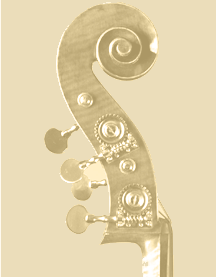3/4 Upright Bass
3/4 upright basses are by far the most common and popular size
upright bass. Unlike it's violin, viola and cello 'brethren,'
fractions for basses are pretty far ranging. A 3/4 bass sizes
can vary from what people think or use to measure and determine
which factors are most important in declaring the size.
A bass that has a back 43", upper bouts only 19" apart, but has a
long neck (say...44" long string length) could easily be put into
both the 3/4 category or 7/8 depending on which measurement we're
looking at. Some say, one should only consider or use the
measurement from the bridge notches on the top to the very top of
the bass body. This often misrepresents what fractional size
the bass is, because while a bass can have a short measurement here,
(which owes to a shorter string length or neck,) the overall bass
can be big. My big Italian bass is like this and it fits
nicely into a good "3/4" sized upright bass cover.
Most all of the basses at the String Emporium are 3/4. When
looking for a particular size bass always factor in all of the
measurements: the overall back length, the upper bouts (or how far
apart the shoulders are), and the string lengths. The lower
bouts, while it helps size up the bass, isn't really a big factor
playing comfort as it is farther away from the upper body and arms.
Another factor that upright bass players should consider is the
"feel" of the bass. Set up is crucial of course, but even so,
some basses which would normally be bigger basses, tend to minimize
this with a good, "easy" set up and a bass with the character and
string response that is much lower in tension.
So, some basses which can be small, with short dimensions all
around, can feel very hard to play if the response of the bass is
"tight". Again, set up is everything.
About our upright bass setup. These little "pea-shooter" basses
can be set up with low action (if the bass has a lot of tension) and
be the most perfect playing and projecting upright bass you've every
heard. Bigger basses, need to be set up so that the overall
size of the body, and the bass' tension to not make it too unwieldy
to play on.
| |
 |
 |
|


